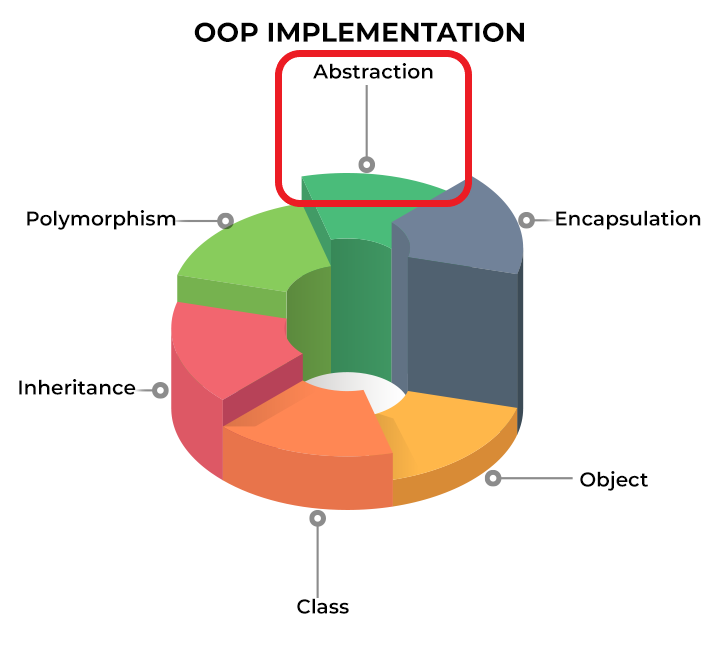Java SE: Abstraction
Java Fundamentals and Principles
1 Overview
📘 Abstraction
Abstraction is the process of focusing on the essential characteristics of an object, while ignoring the non-essential details.
One of the OOP concepts in Java is abstraction, which is the act of representing key features without including supporting information.
It is a method for developing a brand-new data type appropriate for a particular application.
It avoids providing extraneous or pointless facts and only displays the precise portion the user has requested. It is crucial since it prevents you from performing the same task more than once.
Here is an example of abstraction in Java:
public abstract class Account {
// This is an abstract class because it has an abstract method
public abstract void withdraw(double amount);
// Non-abstract methods
public void deposit(double amount) {
// Code for depositing money
}
public void checkBalance() {
// Code for checking account balance
}
}In this example, the Account class is an abstract class because it contains an abstract method called withdraw(). An abstract method is a method that is declared but not implemented. This means that subclasses of the Account class must implement the withdraw() method in order to use it.
2 Abstract class and Interface
Abstraction is an important concept in object-oriented programming because it allows developers to create complex systems by building upon simpler components.
This makes it possible to manage large and complex code bases without becoming overwhelmed by the details.
In other words, abstraction means representing the essential features of an object without including the non-essential details. In Java, abstraction is achieved through the use of abstract classes and interfaces.
📘 How abstraction is done
In Java, abstraction is achieved through the use of abstract classes and interfaces.
An abstract class is a class that contains one or more abstract methods. An abstract method is a method that is declared but not implemented. This means that subclasses of the abstract class must implement the abstract methods in order to use them.
Here is an example of an abstract class in Java:
In this example, the Shape class is an abstract class because it contains an abstract method called getArea(). Subclasses of the Shape class, such as Circle or Rectangle, must implement the getArea() method in order to use it. This allows each subclass to provide its own implementation of the getArea() method, based on its specific characteristics.
Interfaces are another way to achieve abstraction in Java. An interface is a collection of abstract methods and constant variables. A class that implements an interface must implement all of the abstract methods and constant variables defined in the interface.
Here is an example of an interface in Java:
In this example, the Shape interface defines three abstract methods and one constant variable. Any class that implements the Shape interface must implement all of the abstract methods and provide a value for the constant variable. This allows the class to define its own implementation of the abstract methods, based on its specific characteristics.
Here is an example of how to implement the Shape interface in Java with Circle class:
public class Circle implements Shape {
// Private instance variable
private double radius;
// Constructor
public Circle(double radius) {
this.radius = radius;
}
// Implementation of abstract method from Shape interface
@Override
public double getArea() {
return Math.PI * radius * radius;
}
// Implementation of abstract method from Shape interface
@Override
public void draw() {
// Code for drawing the circle
}
// Implementation of abstract method from Shape interface
@Override
public void move(int x, int y) {
// Code for moving the circle
}
}In this example, the Circle class implements the Shape interface. This means that the Circle class must implement all of the abstract methods defined in the Shape interface. The Circle class also has a private instance variable called radius, which is used to store the radius of the circle.
The Circle class provides its own implementation of the getArea() method, which calculates the area of the circle based on its radius. It also provides its own implementation of the draw() and move() methods, which are used to draw and move the circle on the screen.
Overall, this example shows how to implement an interface in Java. By implementing the Shape interface, the Circle class can provide its own implementation of the abstract methods defined in the interface, based on its specific characteristics.
3 Conclusion
Overall, abstraction is a powerful concept that allows developers to create complex systems by building upon simpler components. It helps to manage the complexity of large code bases by focusing on the essential features of objects, while ignoring the non-essential details.
